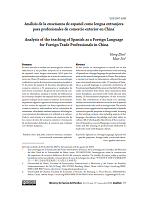Analysis of the teaching of Spanish as a Foreign Language for Foreign Trade Professionals in China
DOI:
https://doi.org/10.32870/mycp.v13i37.865Keywords:
Spanish as a foreign language, Spanish for specific purposes, foreign trade, vocational education, applied educationAbstract
In this article, an investigation is carried out on the deficiencies and possible improvements in the teaching of Spanish as a foreign language for professionals who work in the area of foreign trade in China. The analysis is carried out based on information collected through semi-structured interviews with: (1) teachers of Spanish as a second language in university institutions of Vocational and Applied Education in the field of foreign trade; (2) teachers from those same institutions that teach disciplines associated with trade abroad; and, finally, (3) businessmen/employees of this economic sector. The contribution of this article is to identify, analyze and reveal the deficiencies in the use of Spanish by professionals who work in foreign trade. The article presents some suggestions for improvement in Spanish courses for specific purposes in foreign trade, focusing on the teaching content, also including aspects of the language, disciplinary knowledge and what refers to culture. All of which guides the reform of the construction of Spanish as a second language courses in foreign trade and the training of professionals dedicated to trade who work with Hispanic clients.Downloads
References
Consejo de Estado. (2014, mayo 02). Pautas para acelerar el Desarrollo de la Educación Vocacional Moderna, (Guofa [2014], No.19). Gobierno de la República Popular China. http://www.gov.cn/zhengce/content/2014-06/22/ content_8901.htm
Consejo de Estado. (2017, diciembre 19). Directrices para Profundizar en la Integración de Producción y Educación. (Guobanfa [2017], No.95). Gobierno de la República Popular China. http://www.gov.cn/zhengce/con¬tent/2017-12/19/content_5248564.htm
Dudley-Evans, T., & St John, M-J. (1998). Developments in English for Specific Purposes: A multi-disciplinary approach. Cambridge University Press.
Fernández, L. (2006). ¿Cómo analizar datos cualitativos? Butlletí La Recerca, (7), 1-13. https://www.ub.edu/idp/web/sites/default/files/fitxes/ficha7-cast.pdf
Grix, J. (2010). The foundations of research (2nd ed.). Palgrave Macmillan.
Guillemin, F., Bombardier, C., & Beaton, D. (1993). Cross-cultural adaptation of health-related quality of life measures: Literature review and proposed guidelines. Journal of Clinical Epidemiology, 46(12), 1417-1432. https:// doi.org/10.1016/0895-4356(93)90142-n
Hernández Sampieri, R., Fernández Collado, C., & Baptista Lucio, P. (2014). Metodología de la investigación (6a.ed.). McGraw-Hill/Interamericana Editores.
Howatt. A. P. R. (1984). A History of English Language Teaching. Oxford Uni¬versity Press.
Hutchinson, T., & Waters, A. (1987). English for Specific Purposes: A Learning-centred Approach. Cambridge University Press.
Izquierdo, G. M. (2015). Informantes y muestreo en investigación cualitativa. Revista Investigaciones Andina, 17(30), 1148-1150.
Martín-Crespo, M. C., & Salamanca, A. B. (2007). El muestreo en la investi¬gación cualitativa. NURE Investigación, (27), 1-9. https://www.nureinves-tigacion.es/OJS/index.php/nure/article/view/340
Miles, M. B., & Huberman, A. M. (1994). Qualitative data analysis: An expanded sourcebook (2a ed.). SAGE.
Ministerio de Educación. (2014). Aviso del Ministerio de Educación y otros seis departamentos sobre la emisión del Plan para la construcción de un sistema moderno de educación vocacional (2014-2020) (Jiaofa [2014], No. 6). Re¬cuperado a partir de http://www.moe.gov.cn/srcsite/A03/moe_1892/ moe_630/201406/t20140623_170737.html?eqid=cce16333000195b5 000000046449e3cf
Ministerio de Educación. (2015). Aviso de Ministerio de Educación de Plan de Acción de Desarrollo e Innovación en Educación Vocacional (2015-2018) (Jiaozhicheng [2015], No.9). Recuperado a partir de https://baike.baidu. com/item/%E9%AB%98%E7%AD%89%E8%81%8C%E4%B8%9A%E6%95%9 9%E8%82%B2%E5%88%9B%E6%96%B0%E5%8F%91%E5%B1%95%E8%A1 %8C%E5%8A%A8%E8%AE%A1%E5%88%92%EF%BC%882015-2018%E5%B 9%B4%EF%BC%89/18628776?fr=ge_ala
Richards, J. C. (2001). Curriculum Development in Language Teaching. Cam¬bridge University Press. http://dx.doi.org/10.1017/CBO9780511667220
Sandoval Casilimas, C. A. (Coord). (2002). Investigación cualitativa. ICFES. Recuperado de https://studylib.es/doc/3585128/investigaci%C3%B3n-cualitativa.-carlos-sandoval.-bogota.-2002.
Scientific Software Development GmbH. (2018). ATLAS.ti (versión 8.0) [Software]. Scientific Software Development GmbH.
Serbia, J. M. (2007). Diseño, muestreo y análisis en la investigación cualitativa. Hologramática, 4(7), 123-146.
Swales, J. (1990). Genre Analysis: English in Academic and Research Settings. Cambridge University Press.
Taba, H. (1962). Curriculum development: theory and practice. Harcourt, Brace & World.
Wild, D., Grove, A., Martin, M., Eremenco, S., McElroy, S., Verjee-Lorenz, A., & Erikson, P. (2005). Principles of Good Practice for the Translation and Cultural Adaptation Process for Patient-Reported Outcomes (PRO) Measures: Report of the ISPOR Task Force for Translation and Cultural Adaptation. Value in Health, 8(2), 94-104. https://doi.org/10.1111/j.1524- 4733.2005.04054.x
Zhai, H. (2021). L_a_ _f_o_r_m_a_c_i_ón_ _l_i_n_g_üís_t_i_c_a_ _d_e_ _E_L_E_ _p_a_r_a_ _p_r_o_f_e_s_i_o_n_a_l_e_s_ _d_e_ _c_o_m_e_r_c_i_o_ _e_x_t_e_r_i_o_r_:_ _r_e_p_e_r_t_o_r_i_o_ _d_e_ _n_e_c_e_s_i_d_a_d_e_s_ _c_o_m_u_n_i_c_a_t_i_v_a_s_ _y_ _d_e_ _a_p_r_e_n_d_i_z_a_j_e_._ _E_l_ _c_a_s_o_ _d_e_ _l_a_ _E_d_u_c_a_c_i_ón_ _v_o_c_a_c_i_o_n_a_l_ _e_n_ _C_h_i_n_a_ _[Tesis de doctorado inédita]. Universidad de Deusto.
Zhai, H., & Álvarez, M. (2020). El Español como Lengua Extranjera (ELE) con el fin específico del comercio exterior en la Educación Vocacional y Aplicada en China: una revisión sistemática del estado de la cuestión. M_éx_i_c_o_ _y_ _l_a_ _C_u_e_n_c_a_ _d_e_l_ _P_a_c_íf_i_c_o_,_ _9_(26), 117-137. https://doi.org/10.32870/mycp.v9i26.665
Zhang, X. B. (2016). J?yú ESP l?lùn de lái huá sh?ngwù hàny? _xuéxí zh? xuéxí x?qiú f?nx? jí duìcè jiànyì ??ESP???????????????????????] A_n_ál_i_s_i_s_ _d_e_ _l_a_s_ _n_e_c_e_s_i_d_a_d_e_s_ _d_e_ _a_p_r_e_n_d_i_z_a_j_e_ _y_ _c_o_n_t_r_a_m_e_d_i_d_a_s_ _d_e_ _l_o_s_ _e_s_t_u_d_i_a_n_t_e_s_ _d_e_ _c_h_i_n_o_ _c_o_m_e_r_c_i_a_l_ _e_n_ _C_h_i_n_a_ _s_e_g_ún_ _l_a_ _t_e_o_r_ía_ _E_S_P_ _[Análisis de las necesidades de aprendizaje y contramedidas de los estudiantes de chino comercial en China según la teoría ESP] [Tesis de maestría, Shandong University]. Descargado de https://v.hbu. cn/https/77726476706e69737468656265737421fbf952d2243e6359300 68cb8/kcms2/article/abstract?v=3uoqIhG8C475KOm_zrgu4lQARvep2SA-kkyu7xrzFWukWIylgpWWcEusoGLtS8gmXd5qonHHNvqzu4H48vYK_ EEHiac0162Rc&uniplatform=NZKPT

Downloads
Published
Versions
- 2023-12-15 (2)
- 2023-12-15 (1)
Issue
Section
License
Copyright (c) 2023 México y la Cuenca del Pacífico

This work is licensed under a Creative Commons Attribution-NonCommercial 4.0 International License.
Open Access Policy
This journal provides open access to all its contents, in adherence to the principle that making research freely available supports a greater global exchange of knowledge.
MyCP is licensed under a Creative Commons Attribution-NonCommercial license, also known as CC BY-NC.
Contents are published in both PDF and XML formats.
Authors who publish in México y la Cuenca del Pacífico must accept the following conditions:
Pursuant to Mexican copyright laws, México y la Cuenca del Pacífico acknowledges and respects the authors’ moral right and ownership of property rights, which will be assigned to the University of Guadalajara to publish the articles in an open-access mode.
México y la Cuenca del Pacífico does not charge the authors any fees for receiving and processing their articles.
Authors are permitted to enter into other independent and additional contractual agreements for the non-exclusive distribution of the article version published in México y la Cuenca del Pacífico (for example, publishing it in an institutional repository or in other printed or electronic media) as long as they clearly state that the piece was originally published in México y la Cuenca del Pacífico.
Pursuant to the above, once the article is approved for publication, authors must send the Assignment of Rights Agreement form duly filled and signed. This form must be sent to mexicoylacuenca@gmail.com as a PDF file.
Readers/users of México y la Cuenca del Pacífico can freely access the journal new issues as soon as they are uploaded. Readers/users are allowed to cite, share (both electronically and physically), print and distribute the material, provided they expressly state that the work was originally published in México y la Cuenca del Pacífico. Contents are to be properly cited and never for commercial purposes.




